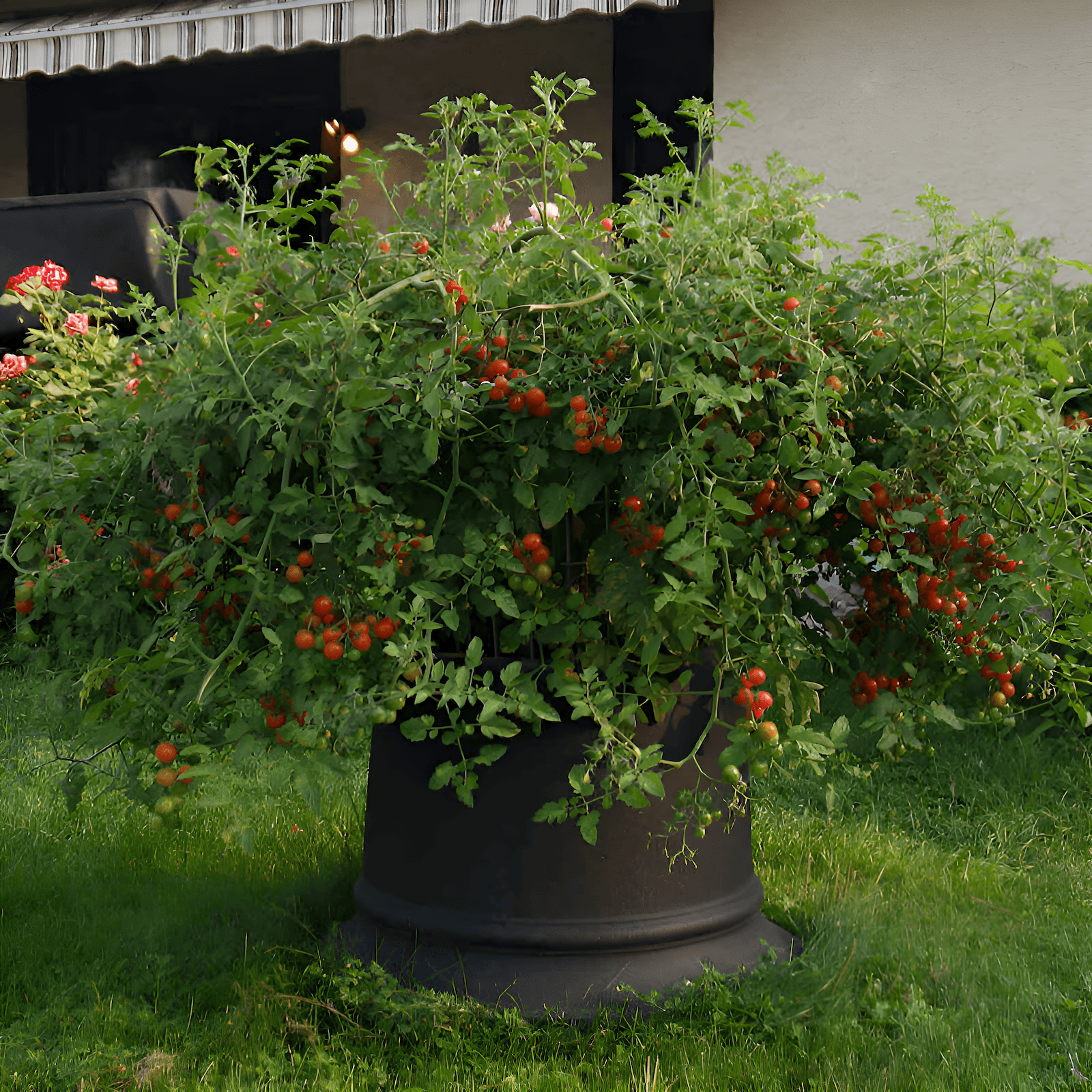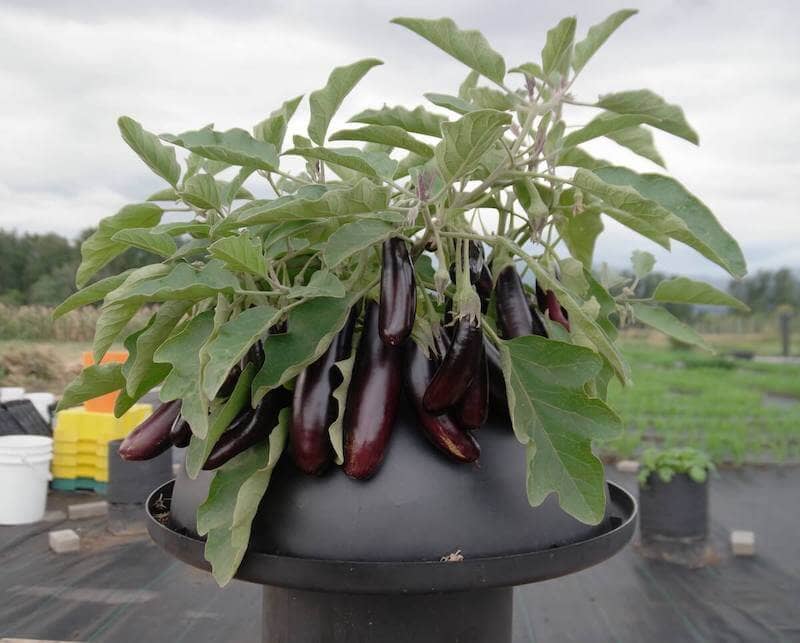
Tomato plants are by far are the most popular plant to grow in the garden and garden containers and the one of the most profitable to grow on a farm. As a result of this popularity, there are hundreds of tomato plant varieties to choose from, all bred from heirlooms common over sixty years ago. Before that tomato seeds were saved from one year to the next and passed down from generation to generation.
There are two types of tomato plants, determinate and indeterminate. Determinate tomato plants grow to a genetically, pre-determined size, which can range from less than a foot to just over two feet tall. Paste tomato plants are almost always determinate and as such are grown commercially in field and mechanically harvested for the food processing industry. Other determinate varieties are grown in gardens and garden containers.
Indeterminate tomato plants grow vines whose length is determined by the first fall frost rather than a generic modification. The long vines of determinate tomato plants require support, particularly if they are grown on garden containers. A vertically orientated wire tomato trellis is typically used.
Unfortunately, for a few generations now, gardeners have been conditioned to grow tomatoes vertically supported by a tomato trellis. The result has been a reduction in the number of tomatoes a tomato plant will produce, sometimes by more than half. Left to vine naturally over the ground much like a cucumber plant, indeterminate tomato plants are encouraged to flower and set fruit more frequently.

Tomato Volcanoes ® offer a new approach to growing tomatoes by creating a natural plant support for uninterrupted vining and increased flower and fruit set.
Instead of guiding by tying one or more tomato plants up through a vertical tomato trellis, a Tomato Volcano creates a parabolic surface for plants and in particular vines of plants to grow over. The surface mimics an undulating ground surface indeterminate tomato plants would grow over where a protective leaf canopy, flowering and fruit set occur in abundance.

Tomato Volcanoes, as the name suggests, are an explosive new way to grow tomatoes. Much like lava in a terrestrial volcano, tomato plants rise from the core to grow over the Tomato Volcano in all directions.
Any of the 3 versions (farm, community garden, and garden container) of the Tomato Volcano suits any indeterminate (vining) tomato type that include beefsteak, globe, and cherry tomatoes. The vines of tomato plants are self-supporting even when laden with heavy fruit. There is no need to tie any portion of the plant to the volcano. The only exception would be in a high wind area where it is desirous to keep vines from bunching to one side in a prevailing wind or from the result of a windstorm.
Depending on climate and growing zone, vines can periodically be trimmed back to the core to regrow multiple tomato crops. With each trim, the plant(s) respond with more vigorous growth, more flowering and more tomatoes because there is an established root system. This trim and regrowth pattern can be repeated until the plant(s) get tired and stop producing, which on average occurs in 2-year intervals.

Different versions of the Tomato Volcano grow different plants – not just tomatoes. The large farm version can grow other long vine plants like cucumber, squash, watermelon, and pumpkin. Smaller versions are designed for growing vegetables, herb, and flower plants in the backyard. Imagine a vertical forest of backyard Tomato Volcanoes featuring elevated plant crowns supported by the trunk like stems of all-weather pipe.

Tomato Volcano Growing Eggplant
Although a member of the nightshade family of plants (think tomatoes and potatoes), eggplant grows much like a pepper plant. Several can be planted at the top of the volcano, up to 5 depending on the variety. Japanese eggplant and Thai eggplant grow extremely well and are particularly abundant. It’s not uncommon that a grouping of 5 Japanese eggplants will produce 60 eggplants on average. No trellising or plant support is needed. The plants intertwine with branches and support themselves. .

Tomato Volcano Growing Chard
Chard is a prolific grower in a Tomato Volcano. All varieties of Swiss chard including Fordhook, colored lights, canary, and rainbow chard grow well. A scatter of approximately 30 seeds will guarantee germination of about 20 plants. As the chard plants leaf, they push against one another and fold over the side of the volcano, providing room for more leaf growth. Leaf stalks cut a couple of inches above the soil will regrow a new crop of chard throughout the season.

Tomato Volcano Growing Squash
Short vine squash plant varieties can be grown in the volcano. Zucchini is the best choice, and many cultivars may be grown including black, yellow, green and ball zucchini. Heavy yields from 3 plants can be expected averaging over 100 zucchini each season. New plant varieties are available for container gardening, and they include Betterbush Butternut, Bush Buttercup, and Table King squash. There are also new compact varieties of cucumber on the market like Spacemaster, Champion, and salad bush cucumbers.
Crop Circle Farms has licensed Tomato Volcano technology to our partner Growing To Give, a 501c3 nonprofit based in Washington. Together, we help Community Gardens grow billions of tomatoes across the country and around the world. Contact Growing To Give, and ask how you can help a community garden where you live.
Ready to transform your land into a high-yield, sustainable farm? Let Crop Circle Farms design and build a custom, low-impact, and water-efficient farm tailored to your needs. Double your income and cut your costs in half! Contact Us
Help us expand our mission to revolutionize agriculture globally. We are seeking partners to implement Crop Circle Farms to feed people in need. Together, we can build scalable food production systems that save water, reduce costs, and feed thousands of people. Contact Growing To Give